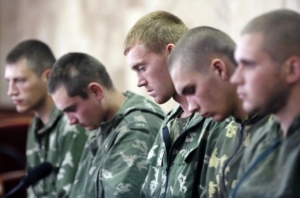Aug. 29: Key events of the day
At dawn, some 1,500 of Ukraine’s army soldiers and volunteer fighters left their positions in Ilovaisk and areas nearby and gathered between the villages of Ahronomichne and Mnohopillia, hoping to leave encirclement in accordance with preliminary agreements with the Russians. As a safety precaution, they divided into two columns, which were to march south by two different routes and meet up once they were through Russian lines.
But the preliminary talks broke down – the Russian officers demanded that the Ukrainian troops had to surrender their arms before leaving the area. Ukraine’s commander on the spot, General Ruslan Khomchak, ordered his soldiers to fight their way out of encirclement. But exhausted and disorganized, many of the Ukrainian troops weren’t aware they were expected to fight, and kept their weapons stowed in cases. Many traveled in unarmored civilian cars and minivans.
The Russians attacked the Ukrainian columns near the villages of Chumaky and Chervonosilske, firing at the civilian vehicles with grenade launchers and machine guns. Hundreds of Ukrainians were killed or were taken captive. Dozens of Russian troops were also killed in fire fights, according to Ukrainians soldiers. The Ukrainian side then retaliated with air strikes and missile attacks. At the end of the day, the military commanders from both sides started negotiations to end the carnage.
Aug. 29, late night. Ukrainian army headquarters in the city of Kramatorsk
Lt.-Gen Yuriy Dumansky took the phone and prepared himself for a tough conversation.
“We have to stop this massacre,” Dumansky said.
The voice at the other end of the line was that of Nikolai Bogdanovsky, the first deputy chief of the General Staff of the Russian Federation.
“He told me it was not up to us, but rather the politicians to look into this matter,” said Dumansky, the former deputy head of the General Staff of Ukraine’s Armed Forces.

Yuriy Dumansky speak to journalists in his office on Feb. 29 in Kyiv. (Oleg Petrasiuk)
However, Bogdanovsky promised the Ukrainians would be assigned a negotiator to liaise with. The idea was to launch a rescue mission and collect killed and wounded Ukrainian fighters after they withdrew from encirclement in the besieged city of Ilovaisk.
As it later turned out, Bogdanovsky kept his word. He warned, however, that the Russians also had to rescue their wounded and remove their dead, so the Ukrainians could only proceed with their mission after them – in a day.
While waiting for access, the Ukrainian army busily formed a medical column with about 70 trucks and ambulances, some of them traveling under the flag of the Red Cross. Colonel Ihor Palahnyuk coordinated the rescue and, according to various reports, found and removed around 159 bodies, evacuated more than 200 wounded, and later provided medical treatment to 400 prisoners whom the Russian army agreed to release.
It took them three days to collect the bodies.
“We had refrigerated trucks and every day each carried from 10 to 15 bodies to the morgues in Zaporizhzhya, Dnipro and Kharkiv,” Dumansky recalled. “It was a tragedy.”

Yuriy Dumansky speak to journalists in his office on Dec. 29 in Kyiv. (Oleg Petrasiuk)
Operation Ilovaisk
In early August, Dumansky was tasked by the Chief of the General Staff Viktor Muzhenko to go to the base camp of the 40th Battalion located some way from village of Kuteinokove, and meet with General Ruslan Khomchak, the commander of the operation to take Ilovaisk.
Khomchak, the head of sector B, was frantically trying to organize the operation for capturing Ilovaisk, but was suffering from a serious shortage of men, according to Dumansky. Apart from a squad from the 51st brigade, no one else was ready to take on the assignment.
“When we planned the initial operation the commanders of the volunteer battalions said they were ready to send 150-200 men from each formation as reinforcements,” Dumansky said. “But when the day of the operation came, the volunteer battalions never gave us any people.”
Some of the volunteer soldiers were ambushed near the village of Mandrykine, 15 kilometers from the Russian-occupied city of Donetsk.
As the initial offensives failed, Khomchak decided to send in Special Tactical Team South, commanded by Andriy Kashuba – a company of troops drawn from various units sent to reinforce the volunteer units in Iloviask.
With their help, by 5 p.m. on Aug. 17, Ukrainian soldiers successfully entered the city for the first time.
Russian invasion
After spending the first two weeks of August around Ilovaisk, Dumansky had to move to Kramatorsk, the new administrative center of Donetsk Oblast, some 540 kilometers southeast of Kyiv.
Around Aug. 20, he learned that the Russians had entered Ukrainian territory.
“They just came across the border and drove along the roads.” Dumansky said. “Who was there to stop them? The border wasn’t secure, and the situation in sector D wasn’t under control. It should have been the main idea of the whole operation – to take the big cities, airports and railroads under control. It was up to the army to do this, but the military units were dispersed throughout the territory.”

A handout photo provided on August 28, 2014 by the Unian Agency shows Russian paratroopers captured by Ukrainian forces near the village of Dzerkalne, Donetsk region, some 20 to 30 kilometres from the Russian border, attending a press conference in Kyiv. (AFP)
